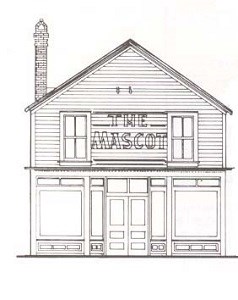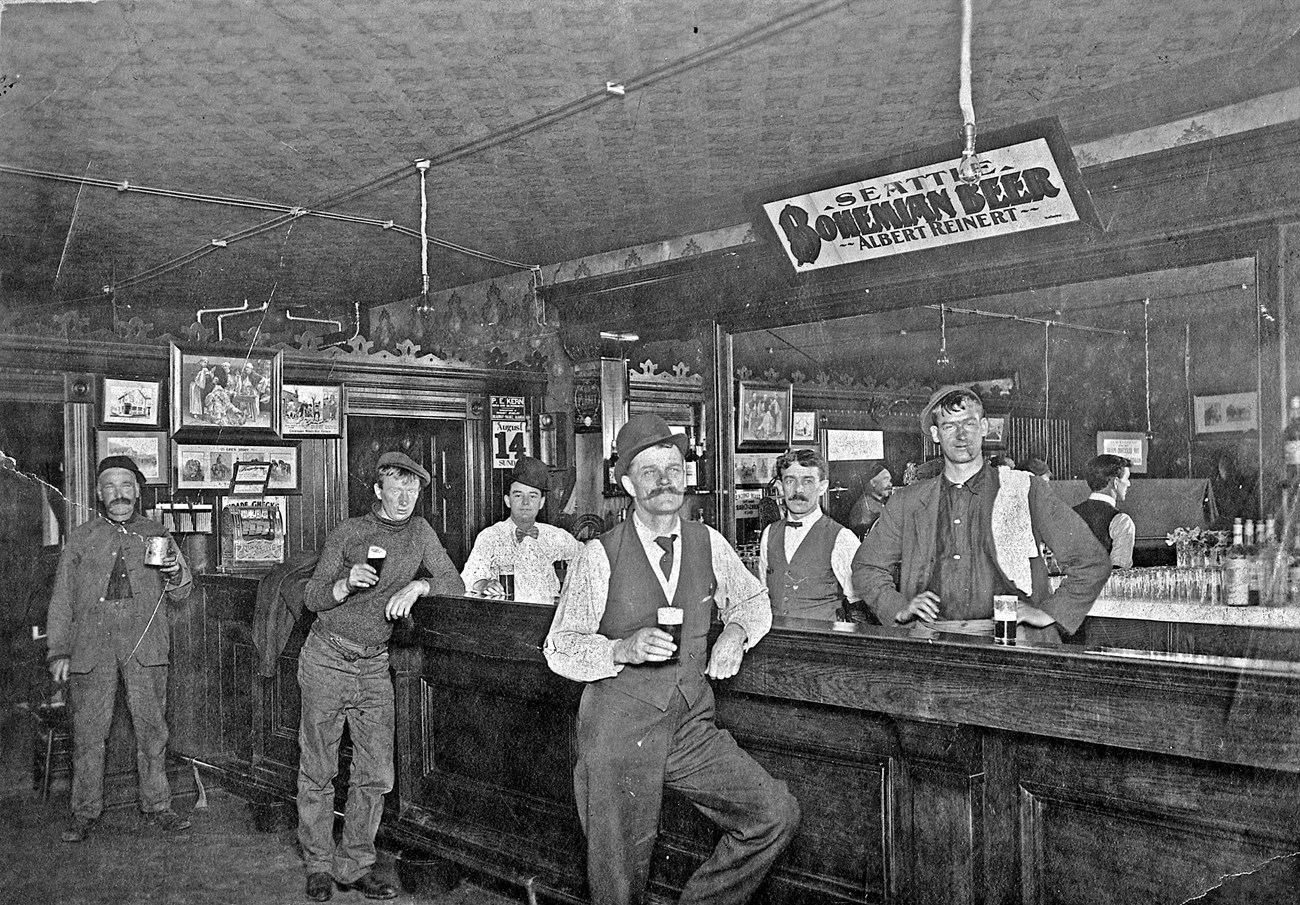
NPS 
NPS Construction BeginsLike many gold rush era buildings in town, no exact date of construction can yet be given for the Mascot Saloon. Dated photographs and other documents suggest that it was built sometime in March 1898. The The Mascotte Becomes The MascotIn early 1899, a new law came into force requiring Albert Reinert was a congenial host. A former restaurant owner, his popular free lunches varied from clam chowder to spareribs and sauerkraut or Mexican enchiladas. Sacke supplied the saloon with locally brewed pilsener beer, which went for a nickel a schooner. Its staff of bartenders was considered "hail fellows." One notable character was Ham Grease Jimmy. According to legend, he was a bartender here until a lucky chip on the right number earned him enough to buy his own saloon, 
National Park Service, Klondike Gold Rush National Historical Park, George & Edna Rapuzzi Collection, KLGO 55810. Gift of the Rasmuson Foundation. A. Reinert's SaloonReinert then began an extensive remodeling and enlargement program. The east wall was removed and the building was doubled in length. A new plate glass façade went in. Telegraph wires were installed, a possible move to get direct reports on sporting events.In 1903 Reinert installed a Victor Talking Machine and advertised an electric concert every night. By 1905, the building reached its present configuration when the corner entry was removed and a new plate glass front and central double-door entry was installed. Located on "Steamboat Row" (named for the numerous steamship companies' offices in the area), the Mascot continued to be popular. Serving longshoremen and others, however, proved troublesome. Fighting, pulling pistols, or throwing stones through the plate glass windows were some of the incidents reported in the local press. Initially women and children were required to use a separate "family entrance" along Third Avenue. They were not allowed to socialize with the men at the bar due to Alaska law. The Mascot was a center for information and activities around Skagway. During the gold rush days, weary stampeders could "flop" their bedroll down on the floor and sleep before setting out on the trail. Newspapers from Skagway and Seattle were sold in town and read out loud at the bar so everyone knew the happenings of the day. The installation of the telegraph line brought in news and sporting events directly to the bar patrons and free lunches were served to the customers to attract business and to get them to drink.
Changing Times Bring Prohibition to SkagwayMeanwhile, moral reforms were sweeping Skagway. In 1903, saloons were forced to close on Sundays and women were barred from entry, even via the "family entrance." In 1916 Skagway voted to go "dry" except for the use of medicinal alcohol. On August 21, 1916, Deputy Marshal Frank Cook closed the town's saloons including the Mascot. The Mascot Saloon, by the way, was one of only the three saloons in Skagway that were founded during the gold rush and survived to local prohibition in 1916. The other two (the Board of Trade and the Pack Train) underwent numerous changes in ownership and location. This makes the Mascot the longest operated saloon in the same location and run by the same owner/proprietor. Reinert's excellent location and stable customer base may have made him the most successful saloon-owner in Skagway.
The National Park Service, Historic Preservation, and Visiting TodayIn 1974 the National Park Foundation acquired the building complex from George Rapuzzi and Charles Hermans and in 1976, the building's ownership was transferred to the NPS. The Mascot Saloon (an exhibit) is still in its original location on the southeast corner of Broadway and Third Avenue (Block 35, Lots 5 and 6). The Mascot Saloon was restored to its 1905-1916 appearance during 1986-1990 at a cost of $1,200,000 for the entire complex. Shortly afterward restoration exhibits depicting town life were installed in the building. This saloon had a fancier bar than most. The beer bottles on display are replicas of the brand distributed by the Mascot during its heyday. Examples of stronger spirits available, rest on the back bar. Cigars were for sale and some of the brands are found in a glass case near the door. The doors behind the bar led to an adjacent business or provided access to an area reserved for gambling. No barstools were provided. Patrons had to stand to drink and socialize. A bar rail, brass spittoons, and bar towels were provided for customers use. National Park Service archeologists have found many artifacts underneath the saloon. Historical photographs and accounts from individuals as well as the artifacts recovered were used to recreate the bar scene. Many of the artifacts on display such as the whiskey bottles, are identical to those found under the building. The bar area is protected by a railing and alarm system. Please help protect the bar scene by staying behind the barrier and not touching the bar and cigar case. Oils in our hands are left on the objects if you touch them, thus, tarnishing the objects. You may take photographs, however. We hope you enjoy the exhibit and the rest of Klondike Gold Rush National Historical Park. |
Last updated: July 29, 2025
